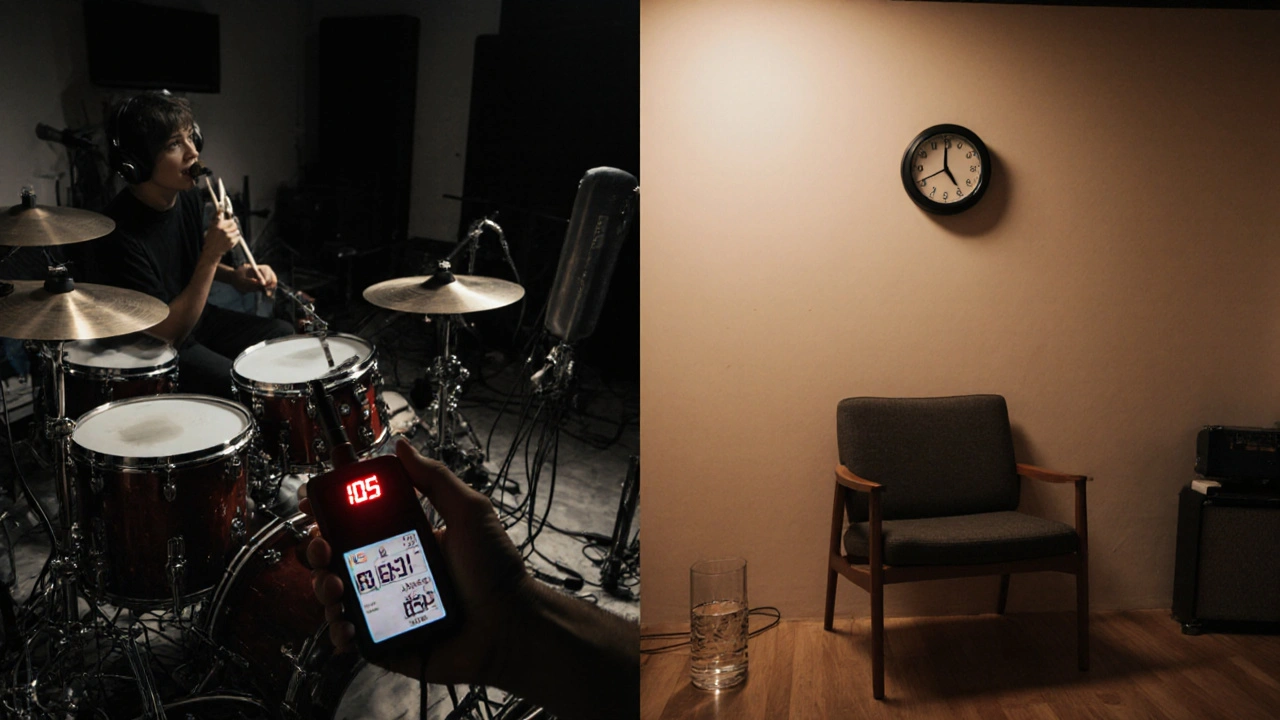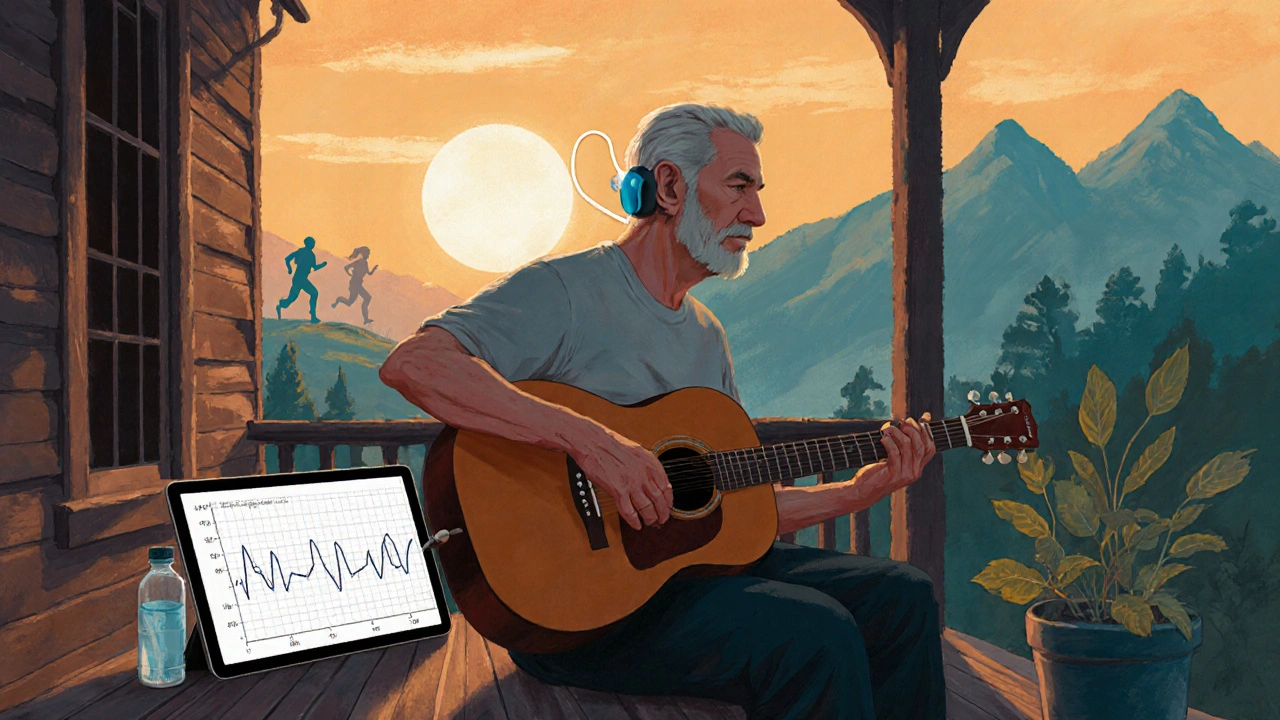Hearing Safety Calculator for Musicians
Calculate Safe Listening Time
Estimate how long you can safely listen to music at a given volume level.
Results:
Understanding Sound Pressure Levels
Compare common sound levels to understand exposure risks.
| Sound Source | Approximate Level (dB) | Risk Level |
|---|---|---|
| Normal Conversation | 60 dB | Safe |
| City Traffic | 70 dB | Safe |
| Rock Concert | 110–115 dB | Very High Risk |
| Rehearsal Room | 85–95 dB | Moderate Risk |
| Power Tools | 100+ dB | High Risk |
When you’re on stage, the roar of amps and crowds can feel electrifying, but that same sound can silently damage your ears. hearing loss in musicians isn’t a distant risk - it’s a daily reality for countless performers.
What Exactly Is Hearing Loss?
Hearing loss is a reduction in the ability to detect sounds across the frequency range. It can be mild, moderate, or severe, and often starts with difficulty hearing high‑frequency tones. For musicians, even a slight dip can mean missing the nuance of a chord or the attack of a drum hit.
Why Musicians Are Especially Vulnerable
Musicians are professionals who regularly work in sound‑intense environments. Whether rehearsing in a cramped studio or playing a festival gig, they encounter sound pressure levels (SPL) that far exceed normal conversation (about 60dB). A typical rock concert can peak at 110‑115dB, and prolonged exposure above 85dB is known to cause noise‑induced hearing loss (NIHL), a type of permanent sensorineural damage.
Key risk factors include:
- Long rehearsals without breaks.
- Use of in‑ear monitors (IEMs) at high volumes.
- Lack of consistent ear protection.
- Ambient venue noise - cheers, crowd shouting, and stage monitors.

Spotting the Early Signs
Many musicians dismiss the first warning bells. Common early symptoms are:
- Ringing or buzzing (known as tinnitus).
- Difficulty hearing higher notes or subtle instrument blends.
- Frequent requests to turn up the volume during rehearsals.
- Feeling “muffled” after a gig.
If you notice these changes, an audiogram - a chart that maps hearing thresholds across frequencies - can confirm early loss.
Preventive Measures Every Performer Should Know
Prevention isn’t about silencing your art; it’s about smart listening.
- Measure the sound. Portable SPL meters (many smartphone apps are calibrated) let you check whether you’re hitting dangerous levels. Aim to stay below 85dB for any continuous exposure.
- Take regular breaks. Every 60 minutes, step away for at least five minutes in a quieter space. This gives hair cells a chance to recover.
- Use appropriate ear protection. Not all earplugs are created equal - see the comparison below.
- Maintain a safe monitor mix. Lower individual channel volumes and use high‑quality IEMs that provide consistent, flat frequency response.
- Schedule annual hearing checks. Early detection through professional audiology can halt further damage.
Choosing the Right Ear Protection
Musicians often think earplugs kill the music experience, but modern designs preserve clarity while lowering SPL.
| Type | Attenuation (dB) | Sound Quality | Customization | Typical Cost (USD) |
|---|---|---|---|---|
| Foam plugs | 15‑30 | Muffled, reduced high‑freq detail | None | 1‑5 |
| Pre‑shaped musician’s plugs (e.g., Etymotic ER20) | 12‑20 | Clear, flat response | None, but size options | 20‑30 |
| Custom‑molded silicone plugs | 10‑25 | Excellent fidelity, tailored fit | Professional impression required | 80‑150 |
| Electronic limiting plugs | Variable (auto‑compresses >90dB) | Natural sound until limit, then reduces | Often semi‑customizable | 120‑250 |
For most touring artists, a pair of pre‑shaped plugs offers the best blend of protection and musical fidelity without breaking the bank.

Treatment Options When Damage Has Occurred
If hearing loss is already present, several pathways can help:
- Hearing aids. Modern devices are discreet and can be tuned for musicians, emphasizing mid‑high frequencies crucial for pitch detection.
- Cochlear implants. Reserved for severe sensorineural loss, they bypass damaged hair cells entirely.
- Sound‑enhancement apps. Apps like “SoundBeam” or “Amplify” use a microphone and earphones to boost specific frequencies in real time.
- Therapeutic counseling. Managing tinnitus often involves cognitive‑behavioral strategies and sound‑masking devices.
Working with an audiologist familiar with musical professions ensures settings that preserve dynamics and spatial imaging.
Long‑Term Lifestyle Tips
Beyond gear, adopt habits that protect hearing for life:
- Keep personal music players at ≤70dB. Use volume‑limiting headphones.
- Stay hydrated - dehydration can affect inner‑ear fluid balance.
- Limit exposure to noisy non‑musical environments (construction sites, loud bars).
- Exercise regularly; good cardiovascular health supports auditory function.
- Educate bandmates and crew about hearing health; a collective approach reduces risk.
Frequently Asked Questions
How long can I safely listen to music at 100dB?
At 100dB, the safe exposure limit is about 15 minutes. Anything longer increases the risk of NIHL dramatically.
Do custom‑molded earplugs hurt to insert?
When fitted by a professional, they should feel snug but not painful. Over‑insertion can cause discomfort, so follow the audiologist’s instructions.
Can I still hear well on stage with hearing aids?
Yes. Many musicians use “musician‑programmed” hearing aids that amplify frequencies essential for performance while keeping ambient noise low.
Is tinnitus always permanent?
Acute tinnitus often resolves after a few days of rest. Chronic tinnitus may persist, but sound therapy and counseling can reduce its impact.
How often should I get a professional hearing test?
Annual audiograms are recommended for active musicians. If you notice new symptoms, schedule a check sooner.


gary kennemer
October 10, 2025 AT 15:17Listening at high volumes may feel exhilarating during a gig, but the cumulative stress on your cochlea can lead to permanent threshold shifts.
Even a few minutes above 85 dB can accelerate hair cell damage, especially when exposure repeats night after night.
Consider using high‑fidelity in‑ear monitors with volume limiting features, and schedule regular hearing check‑ups with an audiologist.
Adopting a philosophy of “play smart, not just loud” can extend both your career and your love for music.
Payton Haynes
October 15, 2025 AT 17:00The music industry secretly hides the real dangers of loud stages so they can keep selling amps and ear‑plugs that don’t work.
They want you to think it’s just part of the rock lifestyle, not a plot to profit from your hearing loss.
Earlene Kalman
October 20, 2025 AT 18:43Musicians act like they’re invincible, ignoring the science that loud sound kills hearing cells.
It’s reckless, and the lack of responsibility is glaring.
Brian Skehan
October 25, 2025 AT 20:26Sure, there’s marketing hype, but the real issue is that many venues ignore OSHA guidelines, which is a bureaucratic failure, not some grand conspiracy.
Andrew J. Zak
October 30, 2025 AT 22:08It’s wise to invest in custom‑molded earplugs that reduce decibels without muffling the music.
These tools let you protect your ears while staying true to your sound.
Dominique Watson
November 4, 2025 AT 23:51British musicians have long prioritized audio standards, a practice other nations should emulate.
James Waltrip
November 10, 2025 AT 01:34While your advice is commendable, it overlooks the cultural significance of sonic intensity in certain genres; the pursuit of purity in sound must be balanced against the ethical duty to safeguard the artist’s physiological integrity, lest we sacrifice humanity on the altar of aesthetic excess.
Chinwendu Managwu
November 15, 2025 AT 03:17Honestly, I think the calculator is just a gimmick 😏.
Kevin Napier
November 20, 2025 AT 05:00Hey, it’s easy to feel overwhelmed, but remember that small changes like taking 10‑minute breaks between sets can make a big difference for your long‑term health.
Sherine Mary
November 25, 2025 AT 06:43Everyone who reads this article clearly doesn’t understand basic audiology; it’s obvious that prolonged exposure above 90 dB will irreversibly damage the inner ear, a fact proven countless times.
Summer Medina
November 30, 2025 AT 08:26First of all the article has several factual errors that need to be addressed. The claim that 85 dB is a safe threshold is outdated according to the latest research from the WHO. In reality the safe exposure limit is much lower when you consider cumulative daily noise. Moreover the table fails to mention that city traffic can sometimes reach 80 dB during rush hour. Also the phrase “Very High Risk” is vague and should be quantified in terms of decibel SPL. The calculator algorithm also oversimplifies the 3‑dB exchange rate, ignoring the 5‑dB rate used in some standards. Furthermore the use of “approximate” without citation undermines credibility. It is also important to note that in‑ear monitors can cause occlusion effect which the article does not discuss. Musicians often neglect the need for periodic audiometric testing, something the article should stress more. The safety advice neglects the role of genetic predisposition to hearing loss. I would also add that hearing protection devices should have at least a NRR of 24 dB. Additionally, the article does not consider the impact of low‑frequency noise on vestibular function. The tone of the piece seems to assume all readers have a basic understanding of acoustics, which is not the case. Finally, the lack of references makes it hard to verify any of the presented numbers. In short, the content needs a thorough review before it can be trusted.
Joshua Brown
December 5, 2025 AT 10:08When planning a live set, it’s essential to assess the venue’s sound pressure level, to calibrate your monitor mix, to schedule regular ear‑check intervals, and to educate band members about the cumulative risk.
Start by measuring the dB SPL with a calibrated sound level meter, then compare it against the OSHA permissible exposure limit, which recommends an eight‑hour dose at 85 dB, with a 3‑dB exchange rate for longer exposures.
If the reading exceeds 95 dB, consider reducing stage volume by at least 5 dB, using directional speakers, or adding acoustic barriers, all of which can dramatically lower the overall intensity.
In addition, provide each musician with high‑fidelity custom earplugs that maintain frequency response, encourage the use of “quiet breaks” every 60‑90 minutes, and keep a log of exposure times, which can be reviewed monthly with an audiologist.
By integrating these practices, you not only protect hearing health, but you also preserve the dynamic range and clarity of the music, ensuring that both performers and audiences enjoy a balanced auditory experience.
andrew bigdick
December 10, 2025 AT 11:51That’s solid advice – do you think a quick decibel readout on a smartphone is reliable enough for those “quiet breaks”?